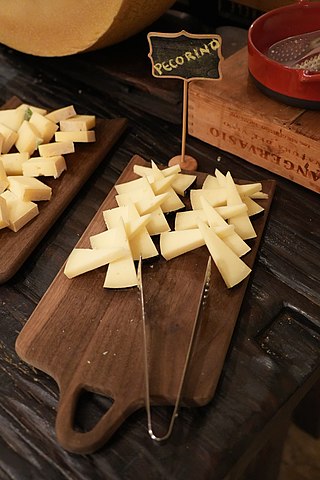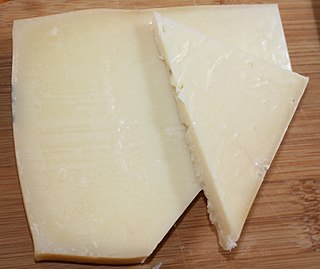Related Research Articles

Halloumi or haloumi is a cheese of Cypriot origin made from a mixture of goat's and sheep's milk, and sometimes also cow's milk. Its texture is described as squeaky. It has a high melting point and so can easily be fried or grilled, a property that makes it a popular meat substitute. Rennet is used to curdle the milk in halloumi production, although no acid-producing bacteria are used in its preparation.

Roquefort is a sheep milk blue cheese from Southern France. Though similar cheeses are produced elsewhere, EU law dictates that only those cheeses aged in the natural Combalou caves of Roquefort-sur-Soulzon may bear the name Roquefort, as it is a recognised geographical indication, and has a protected designation of origin.

Pecorino cheeses are hard Italian cheeses made from sheep's milk. The name "pecorino" derives from pecora, which means "sheep" in Italian.

Kashkaval is a type of cheese made from cow's milk, sheep's milk or both. In Albania, Bulgaria, North Macedonia, Romania and Serbia, the term is often used to refer to all yellow cheeses. In English-language menus in Bulgaria, kashkaval is translated as "yellow cheese".

Cheesemaking is the craft of making cheese. The production of cheese, like many other food preservation processes, allows the nutritional and economic value of a food material, in this case milk, to be preserved in concentrated form. Cheesemaking allows the production of the cheese with diverse flavors and consistencies.

Kefalotyri or kefalotiri is a hard, salty white cheese made from sheep milk or goat's milk in Greece and Cyprus. A similar cheese Kefalograviera, also made from sheep or goat milk, is sometimes sold outside Greece and Cyprus as Kefalotyri. Depending on the mixture of milk used in the process the color can vary between yellow and white.

Manchego cuisine refers to the typical dishes and ingredients in the cuisine of the Castilla–La Mancha region of Spain. These include pisto, gazpacho manchego, Manchego cheese, the white wine of La Mancha, and the red wine from Valdepeñas (DO).

Nabulsi is one of a number of Palestinian white brined cheeses made in the Middle East. Its name refers to its place of origin, Nablus, and it is known throughout the West Bank and surrounding regions. Nabulsi, along with Akkawi cheese, is one of the principal cheeses consumed in Jordan. It is produced primarily from sheep's milk; alternatively, goat's milk may be used. Nabulsi cheese is white and rectangular in shape. It is semi-hard with no gas holes. It becomes soft and elastic when heated. It is a typical ewe's or goat's milk cheese, but is traditionally flavored with mahleb and mastic added to the boiling brine. It is a major ingredient of the Middle Eastern dessert knafeh.

Syrian cuisine is a Middle Eastern cuisine that includes the cooking traditions and practices of modern Syria, merging the habits of people who settled in Syria throughout its history.

Cheese is a dairy product produced in a range of flavors, textures, and forms by coagulation of the milk protein casein. It comprises proteins and fat from milk. During production, milk is usually acidified and either the enzymes of rennet or bacterial enzymes with similar activity are added to cause the casein to coagulate. The solid curds are then separated from the liquid whey and pressed into finished cheese. Some cheeses have aromatic molds on the rind, the outer layer, or throughout.

Castelmagno (DOP) is an Italian cheese originating from the Piedmont region. It has a protected designation of origin status in the European Union.

Graviera is a cheese from Greece produced in various parts of Greece, the main of which are Crete, Lesbos, Naxos and Amfilochia. It resembles gruyère, a Swiss cheese from whose name "graviera" is derived.

There are several regional types of Serbian cheeses, such as the Sjenica, Zlatar, Svrljig and Homolje cheeses. The Pule cheese has gained much notoriety since 2000s as it became the most expensive cheese in the world.
References
- ↑ George Patrick Sanders (1953). Cheese Varieties and Descriptions. U.S. Department of Agriculture. p. 4.
- ↑ Culture Magazine; Laurel Miller; Thalassa Skinner (15 May 2012). Cheese For Dummies. John Wiley & Sons. p. 212. ISBN 978-1-118-09939-1.
- ↑ Jeanette Hurt; Steve Ehlers (1 April 2008). The Complete Idiot's Guide to Cheeses of the World. DK Publishing. p. 309. ISBN 978-1-4406-3618-9.